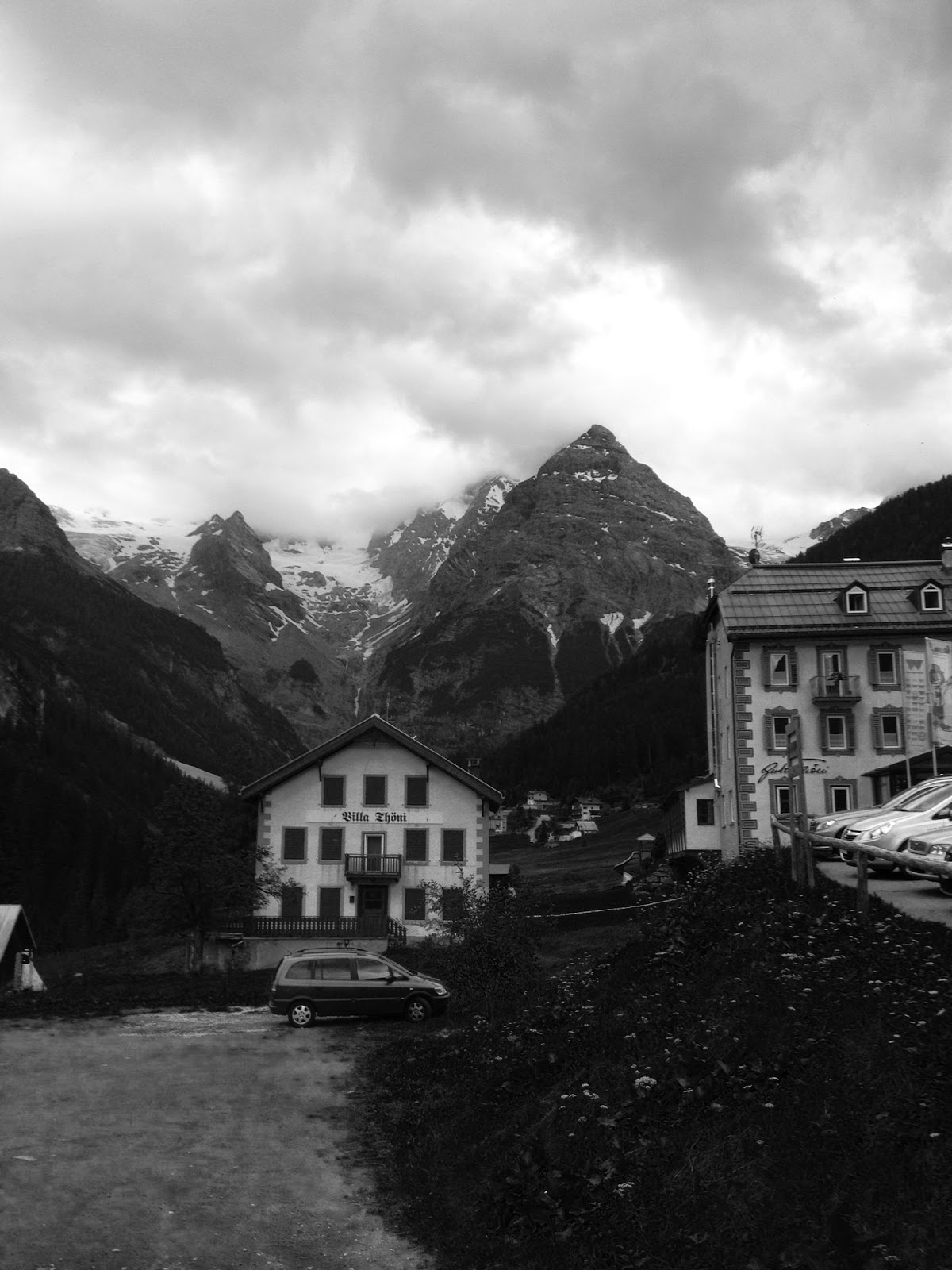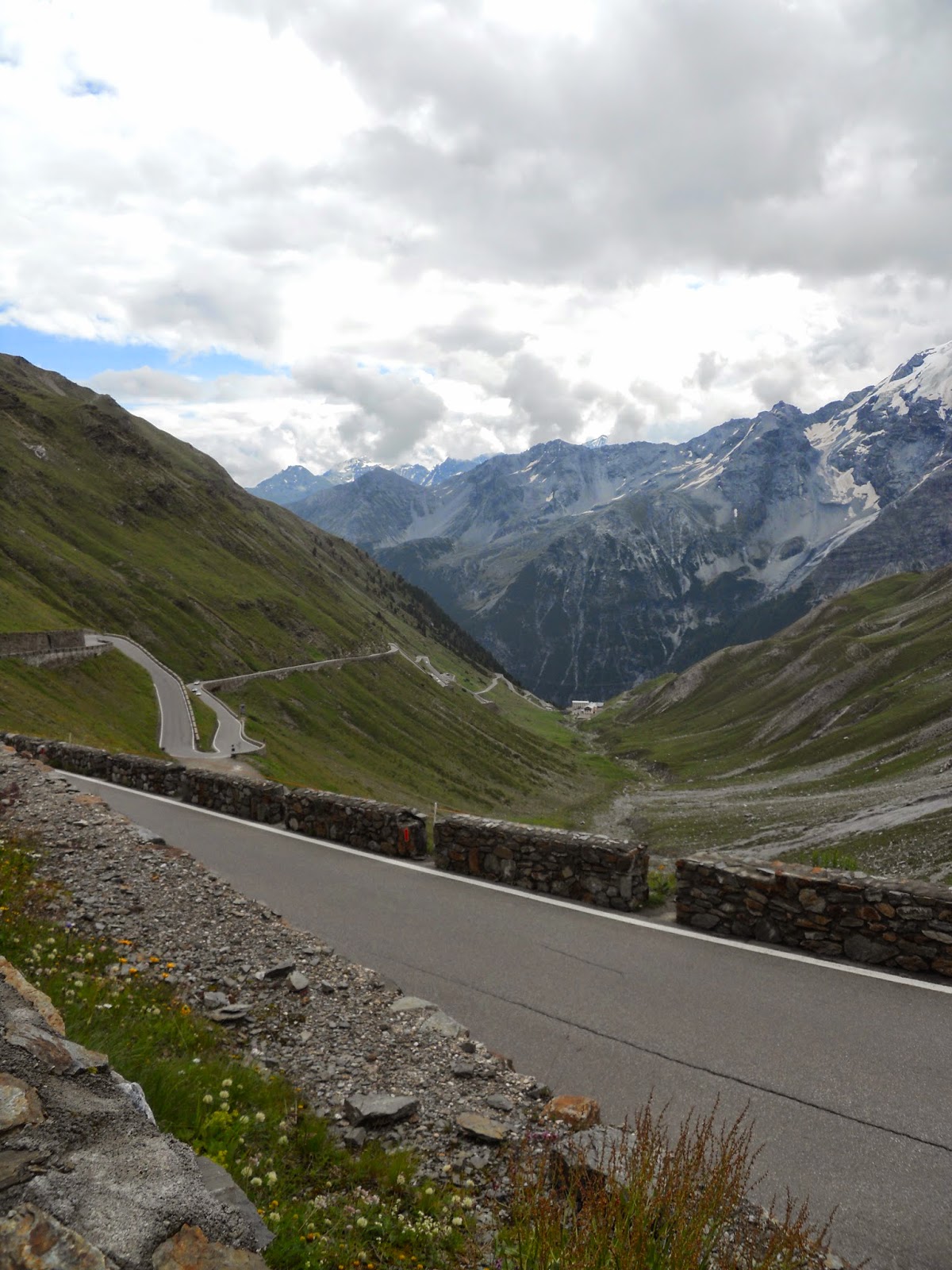Trafoi to Bormio.
 The days of me completing a 25k climb with a loaded bike are
slipping into the grey sands of time on a grey beach under a grey sky. It is
not that I don’t feel capable physically – it is the mind over matter challenge
of maintaining a healthy interest in a three or four hour climb. I set this up so
that we would split the climb into the easy and hard parts. With any climb the descent
cannot be taken for granted as it will possesses completely different dangers
to the ones faced on the ascent and all faced at nearly ten times the speed. So
I wanted to be going up – then down - the Stelvio early on a weekday – less traffic, muscles recovered from the previous day's jollies and, usually, a cooler temperature. The weather provided a
short window of opportunity in the swathe of rain that had covered the trip: 8am –
noon would be rain-free and sunny.
The days of me completing a 25k climb with a loaded bike are
slipping into the grey sands of time on a grey beach under a grey sky. It is
not that I don’t feel capable physically – it is the mind over matter challenge
of maintaining a healthy interest in a three or four hour climb. I set this up so
that we would split the climb into the easy and hard parts. With any climb the descent
cannot be taken for granted as it will possesses completely different dangers
to the ones faced on the ascent and all faced at nearly ten times the speed. So
I wanted to be going up – then down - the Stelvio early on a weekday – less traffic, muscles recovered from the previous day's jollies and, usually, a cooler temperature. The weather provided a
short window of opportunity in the swathe of rain that had covered the trip: 8am –
noon would be rain-free and sunny.
The Stelvio Pass is tough but not difficult – if there is a
difference.
The first section beyond Trafoi consists of long stretches between the occasional hair-pin. Then, all of a sudden and as if by magic, there is a cluster of steep bends before another period of long stretches takes you to Bend 32 when they come thick and fast.
The first section beyond Trafoi consists of long stretches between the occasional hair-pin. Then, all of a sudden and as if by magic, there is a cluster of steep bends before another period of long stretches takes you to Bend 32 when they come thick and fast.
At Bend 22 – by a hotel and its cafe -
you are faced with the wall rising above you at the head of the valley and the
remaining 21 bends - the business end of the climb – but the 10%+ ‘ramps’ are
quite short and for most part the elevation hovers around 10%. There are
occasional markers with the elevation and distance that reassure you that the
going is not likely to get any worse.
The road was built in the early 19th century by
Carlo Donegani, who obviously had nothing better to do than traipse about the Alps
checking out good spots for such a road. It formed part of the Hapsburg’s
European domination that terminated with WW1 when the
aforementioned region was annexed to Italy. The Austrians cannot complain too much
what with all the annexing they’d been up to in Italy during their empire days.
Starting at 8.30am on a Monday, the first hour on the
Stelvio was quite quiet but towards mid-morning the growl of baritone
motorbikes filled the valley from above and below and soon after boy-racers
could be heard screaming up the SS38.
There is plenty of space at each bend and
time to see things coming – especially the scheduled bus. Just keep your ears
and eyes wide open and be careful as you pull out on right-handers to make the
camber as a stealthy, descending cyclist may be hurtling down around the corner.
We encountered a lad from Nottingham who'd had a blow-out and
crash coming down. All shook up from the crash, he was still shaking as he
tried pulling himself together on the gravelled space on the cusp of a bend.
With a couple of scars and a trashed derailleur, we flagged down a passing car
who could give him a lift to the top.
Every twist and turn provides a breathtaking view of the gathering valley below. Glaciers hang precariously between the three peaks. The views and the short stages - each with their end in sight makes the Stelvio easier to bear than, say, Ventoux with its relentless journey through a dull forest and no respite before it gets to the moonscape.
At the top the final bend resembles Kao San Rd in Bangkok – albeit with German and Italian flavours – with several shops selling Stelvio merchandise – shirts, t-shirts, teddy bears, duvet covers, lampshades, three piece lounge suits (awkward to get on the bike) etc. As one vendor tried persuading me about the garish shirt she offered me – ‘not made in China, made in Italy’, I, instead, bought my garishly coloured exclusive shirt from chap a few stalls on who offered me the bonus of a pair of socks all for €55 – he saw me coming. Well - whatever.
Down the other side. There was all kinds of preparation on the acme of the hill for those heading down. The customary newspaper down the shirt plus gloves, tights...It gets cold going downhill. Also, eat and drink as you don't want anything seizing up at the wrong time. Finally, check everything is attached to the bike as it should be - especially the panniers as they will jump at the chance to bounce about and fall off.
And the off: after a sweeping bend we came to a stack of hairpins and then the feature I dreaded the most – six tunnels in quick succession. Fortunately, traffic was thin on the ground, which was just as well considering the quality of the road surface lurking within the dank darkness.
Out of those and D got a puncture – the unthinkable that we had
already seen the consequences of on the way up. D’s flat, thankfully, wasn’t a
blow out. As he did the needful the weather changed very quickly and I saw
monstrous rain-packed clouds moving up the valley. I took refuge in a seventh
tunnel as the deluge poured down from the sky. Once the rain had passed we sped
down to Bormio and beyond. There is a road that flanks the autostrada and gets
you to Tirano safely and provides more fantastic views.
It was 4pm by the time we got to Tirano and we needed to be
in Colico on Como and so I’d planned that we’d avail ourselves of the train.
This cost us €17 for the hour long journey down what became the usual low Alp
valley – busy and crammed with villages and ugly industrial areas. The weather
caved in once more and though we were spared another deluge as we put our tents
up, as soon as we returned from the restaurant the weather turned it up
again. The weather was appalling. At the campsite we met four brothers were cycling from Eindhoven to Rome – a popular route for the Dutch as they were the second group we'd met on that mission. A Dutchman has written an inch-by-inch book about the route – a best seller in Holland they said.
 |
| Como |


















No comments:
Post a Comment